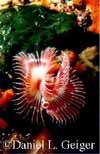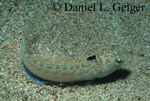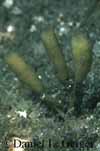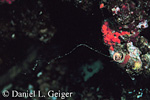INDEX
Underwater (UW) Photography
Range of Equipment: The simplest version is the Kodak and Fuji instamatic cameras, which consists of a disposable camera with film. They can be used for surface photographs and up to a depth of 3 m in well-lit waters, as no artificial light source (flash) is available for this camera. The Minolta Weathamatic (and similar of a few other brands) can be used to a depth of up to 10 m, and has a small built in flash. As the flash is more or less in the optical axis of the lens, heavy reflection from any suspended particles must be accepted ("snowed" pictures). This camera is also just usable in transparent waters of the tropical oceans. It is affordable (X00 US$) and gives reasonable results. Ewamarine produces PVC bags for most still cameras and even video cameras. Supposedly they are working to a depth of 10m. However, as the bags are compressible you have the choice of two trade-offs: Either, you put little air in the bag and adjust the camera at the surface as such is impossible at depth, because the bag clings firmly to the camera (special problems with AF cameras arise !); or you fill the camera with air on the surface to make it operable at depth, however, having great difficulties to get the whole thing down in the first place. In my opinion, these bags are perfectly suitable for surface shots and in bad weather outdoor, but are of no value for true UW photography. The next group of cameras are 135-format (24 x 36 mm negative) viewfinder cameras, which are specially designed for the use UW up to a depth of 30-40m. The best known brands are Sea & Sea, Motormarine and the Nikonos family. Interchangeable lenses and various supplementary flashes are available, of which many work in TTL mode (Nikonos V plug). The whole system is handy and with 1 to 2 kg on land not too heavy. However, as these cameras are viewfinder cameras, problems connected to parallax tilt arise. On certain dive bases Nikonos cameras can be hired for an exorbitant rent.
Very recently, Nikon has introduced a Nikonos-style SLR camera, the Nikonos RS. It claims to be the ultimate camera for UW use and should bring an end to the housings. BUT: The design is made in a fashion, that operation with 5-7 mm gloves is virtually impossible, it is 1 kg negatively buoyant, just three lenses are available up to date, and the price is comparable to a housing system. The only advantage is that the size is comparable to the other Nikonos cameras. Features such as synchronization of the flash on first or second shutter are of no practical use what so ever. UW cameras need a lot of care. Many O-rings are found in a UW camera, and particularly in housings. They have to be greased regularly with silicon grease (mineral greases destroy rubber !) and have to be kept dust free in order to prevent leakage. Highly viscous silicon grease is preferable, such as those used for high-vacuum systems; environmental grease of SCUBA equipment manufacturers will be washed off immediately. Although the cameras are pressure resistant, they are rather shock sensitive. Flash cables must not be bent, otherwise the camera may be flooded through the cable. Never let sea water dry on a UW camera; if you cannot rinse it immediately in fresh water, keep it moist in a wet towel. Water as a medium to photograph in: For the same reason also some problems with artificial light sources arise. As the light passes the water, the red part of the spectrum is filtered out, rendering the light colder, i.e. more blue and increasing the color temperature. For this reason, most UW flash tubes are of a warm 5,000K, and with some flashes even the reflector can be exchanged (Hardenberger down to 4,000K) in order to adjust the color temperature to the working distance. An other problem is the correct f-stop calculation UW. As the water absorbs much more light than air the indication of the strength of the flash (guide number) has to be adjusted. Most UW flashes have an UW guide numbers of 8 - 16 (The Hardenberger 500 TTL might have 22: Do not believe a single word in an advertisement !!! Herbert Frei has meticulously documented in UWF 2/92 pp.46-57 in his report " Die Stunde der Wahrheit" (The hour of truth) all the lies that producers tell. The DIN UW guide number usually is one f-stop too high). On the surface the UW guide number can be multiplied by a factor of 3-4. The illumination angle of an UW flash is in reality 45-90¡ (ad: 100° corresponding to the collecting angle of a 20 mm lens). Therefore, the use of two flashes is highly recommended with super-wide angle lenses (f < 24 mm).
The diver him-/her-self can contribute to a great extend to the amount of suspended particles in the water column by stirring the bottom. UW photographers tend to move very slowly, sometimes even appearing unconscious. Much of the movement is done by using the lungs for fine regulation of the buoyancy as opposed to fin work. UW photographers tend to be annoyed by other divers - mud producers - and many actually prefer to dive alone. Making all the adjustments, without stirring up any dirt, takes considerable time, typically for a very easy shot 1 minute for more complicated situations, e.g. macrophotographs on a vertical wall, 3-5 minutes. Usually slow slide films are used, personal preferences deciding upon the make. The new Kodak Ectachrome UW ISO 50 film is more red sensitive and adjusted to the 20-30m range of tropical waters, i.e. it is a holiday film. I try since July 1993 to get the technical data sheet from Kodak, but without any success. |
 The next
possibility is to take an SLR-camera and have a housing
built around it. The advantage is that one can frame exactly the picture
one wants to take. However, the housings are bulky and therefore impose
considerable drag UW. Although UW they are usually -0.2 to -0.3 kg
buoyant, on land they weigh 4 - 10 kg. Housings are available for
most cameras and most lenses, lenses being interchangeable only on
land. However, cameras with exchangeable viewfinders are preferred
(Nikon F3, F4, Canon F1, Pentax LX), as the distance between the eye
and the viewfinder is long due to the face mask and the housing: a
sport viewfinder or the LX 45° viewfinder comes in handy. The
cheapish (X kUS$) version is a perspex housing from Ikelite.
The working depth is limited to 40m. The better housings are made
of aluminum among others by Subal, AquaVision and world famous Swiss
Hugyfot with working depth of 70-80m. Such cameras often
are made on special order with customer specifications (X-X0 kUS$)
and the owners are VERY fuzzy about them; don't expect anybody to
lend you their camera. Such housing are also built for middle format
cameras and up to professional betacams (housing only approx. 40 kUS$).
Flashes are connected by the standard Nikonos V plug. Many TTL-systems
are supported by various flashes.
The next
possibility is to take an SLR-camera and have a housing
built around it. The advantage is that one can frame exactly the picture
one wants to take. However, the housings are bulky and therefore impose
considerable drag UW. Although UW they are usually -0.2 to -0.3 kg
buoyant, on land they weigh 4 - 10 kg. Housings are available for
most cameras and most lenses, lenses being interchangeable only on
land. However, cameras with exchangeable viewfinders are preferred
(Nikon F3, F4, Canon F1, Pentax LX), as the distance between the eye
and the viewfinder is long due to the face mask and the housing: a
sport viewfinder or the LX 45° viewfinder comes in handy. The
cheapish (X kUS$) version is a perspex housing from Ikelite.
The working depth is limited to 40m. The better housings are made
of aluminum among others by Subal, AquaVision and world famous Swiss
Hugyfot with working depth of 70-80m. Such cameras often
are made on special order with customer specifications (X-X0 kUS$)
and the owners are VERY fuzzy about them; don't expect anybody to
lend you their camera. Such housing are also built for middle format
cameras and up to professional betacams (housing only approx. 40 kUS$).
Flashes are connected by the standard Nikonos V plug. Many TTL-systems
are supported by various flashes. Additionally
to the differential absorption of colors with depth, water
is also approximately 800 times denser than air. Whereas
in surface photography the amount of air between the camera and the
object is generally neglectable, UW it plays an important role. In
order to frame the same picture at a closer distance, wide angle
lenses are more commonly used. The 35 mm lens is comparable to
the 50 mm lens on the surface, the 21 mm is comparable to the 35 or
28 mm lens on the surface. Special rules apply to the housings: The
lens is covered with a lens-housing, the so-called "port",
which has a thick walled glass. The light beam is broken when it is
passing the port and causes a narrowing of the collection angle
of the lens: The 50 mm lens becomes an 80 mm lens, the 35 mm
is approximately a 50 mm. For wide angle lenses (f < 50 mm) the glass
is no longer plane, but bell shaped (dome port); to a certain
extent the problems are shunned.
Additionally
to the differential absorption of colors with depth, water
is also approximately 800 times denser than air. Whereas
in surface photography the amount of air between the camera and the
object is generally neglectable, UW it plays an important role. In
order to frame the same picture at a closer distance, wide angle
lenses are more commonly used. The 35 mm lens is comparable to
the 50 mm lens on the surface, the 21 mm is comparable to the 35 or
28 mm lens on the surface. Special rules apply to the housings: The
lens is covered with a lens-housing, the so-called "port",
which has a thick walled glass. The light beam is broken when it is
passing the port and causes a narrowing of the collection angle
of the lens: The 50 mm lens becomes an 80 mm lens, the 35 mm
is approximately a 50 mm. For wide angle lenses (f < 50 mm) the glass
is no longer plane, but bell shaped (dome port); to a certain
extent the problems are shunned.